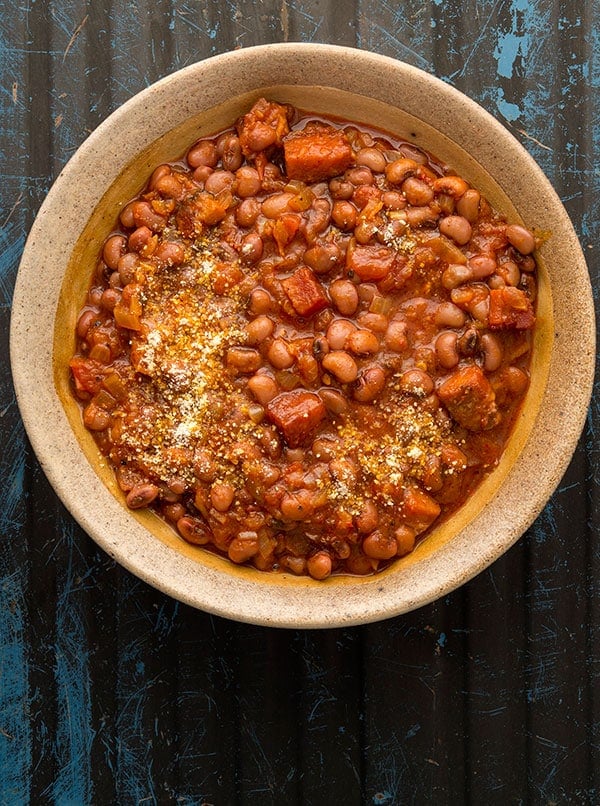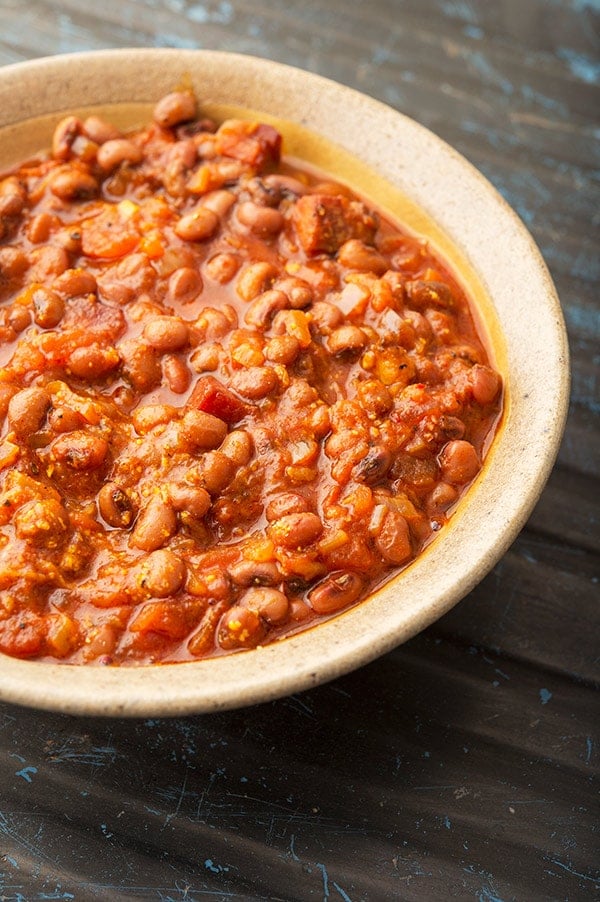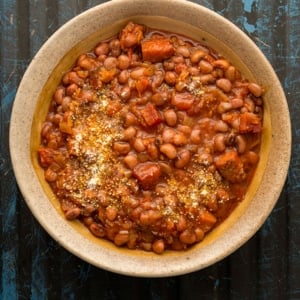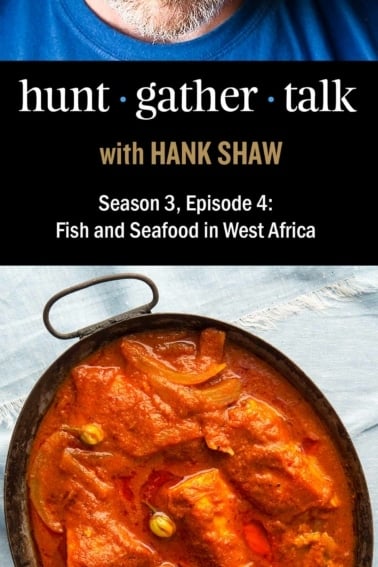As an Amazon Associate I earn from qualifying purchases.

If you like pork and beans and rice, you will absolutely love red red. One of the signature dishes of Ghana, red red gets its name from cowpeas cooked in red palm oil with tomatoes.
I happen to grow a red cowpea called a Bisbee red (it’s from Arizona), and I added some smoked ham to the mix, effectively making this red red red red. Yeah, I am easily amused.
Seriously, though this is arguably the most wonderful bowl of pork and beans I have ever eaten, and that is saying a lot. I eat this combination, with wild or feral pork or javelina, as much as I can. And this recipe wins the prize.
My rendition owes a lot to the recipe I found in what I consider the finest Ghanaian cookbook around, Zoe’s Ghana Kitchen, which, if you are at all interested in West African food, should be on your wishlist.
There are two “odd” ingredients in traditional red red: Red palm oil and gari, which is fermented cassava meal. Red palm oil is actually not terribly hard to find in fancy supermarkets and health food stores, and you can buy sustainably farmed red palm oil here. (You want to try to get sustainably farmed palm oil, because there is a whole industry out there that is wrecking the tropics for this stuff.)

As for gari? I think you can get it online, but you can also just skip it; it’s a garnish.
If you don’t want to go through the trouble of buying palm oil but still want a red oil, set some oil over low heat and drop in a few annatto seeds, or, if you’re like me an like things spicy, some dried red chiles. Let them sizzle gently a few seconds, then take the oil off the heat and let it steep overnight. Voila! Red oil.
Still too much? Use lard or whatever fat or oil makes you happy. Just make this dish.
Oh, and pretty much everyone uses regular black-eyed peas here, not my fancy red ones. That said, if you want to go for full redness, you can buy Sea Island Red Peas, which are very similar.
No matter what bean you use, they must be cooked separately from the rest of the stew because the acidity of the rest of the ingredients will make the beans take hours and hours and hours to cook. This holds true for all beans, incidentally, which is why Boston baked beans take all day.
Typically you would serve your red red stew with fried plantains, but I prefer it over simple white rice.
If you want to serve this as part of a larger West African meal, try it alongside my version of Senegalese mafe, which is a shank (lamb, deer, elk, veal, etc.) braised in a peanut sauce, or a Ghanaian palaver sauce, which is a stew of greens and meat, in my case venison.
Ghanaian Red Red Stew
Ingredients
- 1 1/2 cup cowpeas of any kind (black-eyed peas are the most common)
- 1/4 cup red palm oil, or substitute (see above)
- 1 red onion, chopped
- A 1-inch piece of ginger, peeled and grated
- 1 Scotch bonnet or habanero chile, minced
- 1/4 pound smoked pork, chopped (or ham)
- 1 to 3 teaspoons cayenne
- 1 teaspoon curry powder
- 4 to 6 plum tomatoes, chopped
- 1 cup tomato puree or crushed tomatoes
- 1 tablespoon tomato paste
- Salt and black pepper to taste
Instructions
- Cook the cowpeas in plain water until they are tender. Add a big pinch of salt, cover the pot and remove it from the heat. Set aside for now.
- In a medium pot, heat the palm oil over medium heat. When it's hot, saute the onions for about 3 minutes, then add the Scotch bonnet and the chopped, smoked pork. Saute for another minute or three. Stir in the cayenne and the curry powder, then the chopped fresh tomatoes.
- Add the remaining ingredients and the cowpeas. Remove the cowpeas from their water with a slotted spoon. It's OK if some cooking water gets into the pot. Stir well to combine and simmer for 30 minutes. Serve with fried plantains or simple white rice.
Notes
Nutrition
Nutrition information is automatically calculated, so should only be used as an approximation.





Great use for left over Easter ham! Really easy and great recipe
Hank, I would like to try this but I’m a little conflicted about the first ingredient listed. Is the “1 1/2 cup cowpeas of any kind” as in eleven and a half or one and a half cowpeas? Thanks for sharing!
Phil: One and one-half cups! Sorry about that.
I was looking for recipes that use red palm oil after I had got some to make Brazilian moqueca and came across this. Love it. I made it twice in the past week! I soaked the peas overnight and then did them in the instant pot for 7 minutes then slow release (I live at altitude-Denver so I added a couple of minutes).
This is my first comment and I’ve been following and using your recipes and game prepping tips for years. I love all, of the recipes I’ve made and this is just that latest to be added to the comfort food rotation, with the bonus of using a lot of what we grow and hunt. I appreciate your connection to food and yours is the ONLY food blog I can read and enjoy… there are only so many things that need to be said along with a recipe and your explanation and personality shine through in the right amount of words for me to have a thorough understanding and be entertained ?. Thank you!
Just made a giant batch of this to have for my lunches during the week and wow, just wow. One of the most simple and yet delicious things I’ve ever had. I doubled down on the habanero since I like my food hot…will definitely be making again. I’ll be ordering your book for sure.
This recipe was surprisingly comforting, even on a 111 degree evening. I always grow black eyed peas in the summer gardens and was excited to find a new use for the crop. Adding in fresh tomatoes from the same garden made this meal extremely satisfying. I used olive oil in a pinch and served over white rice. Great, quick meal with plenty of left overs!
Hank – I am really looking forward to trying this one out. Thanks for what you do, by the way. I generally don’t buy pork unless the local butcher has it. How do you think the recipe would fare subbing in some smoked bear chopped up instead? I’ve had a real bear of a time smoking an old, old Grizz (I’m guessing 15-20 year range). The flavor never disappoints, but man it tightens up and I feel like I’m chewing on a tire with some of the roasts I’ve tried to smoke. I’ve tried a variety of things, but hesitant to take it off the smoker at the temp I’d prefer ’cause of trich.
Mike: I think that would be a great idea. Chop it small and let it stew in the beans.
Holy S#i#! Talking about world’s colliding! I lived in Ghana for a few years. This is a terrific dish ( I suggest going for a palm oil substitute since it is bad for the body and environment) and i love your blog. If you serve it with kele wele (spicy plantain) you will love it! Thanks so much for putting a smile on my face during the 10th week of complete lock down!
Jen: Not all palm oil is bad for you or the environment. You can buy red palm oil, the unrefined stuff, that is sustainably farmed.
Jen, contrary to what you may have heard or read, (must be true, read it on the Internet?) palm oil is not bad for the body nor the environment. One of my cooking magazines wrote an extensive and very informative article on this years ago. Like all plants on earth, there are different strains, and entire civilizations have cooked with unrefined palm oil for centuries with zero ill effects. However, when Big Agra got involved, refining it for mass production and deforesting the land, misinformation gave the OIL ITSELF a bad reputation. Don’t fall for it! Like Hank said, it’s worth the effort to seek out and try the unrefined oil in its natural state. It’s really very nice.
This looks great, Hank! I wonder if this is one of theAfrican precursors to Louisiana Red Beans and Rice? So many of our soul food favorites trace their roots back to African cookery.
Chris: I believe it is, actually.
I just wanted to add for anyone who is hesitant on this recipe. It is amazing even when made vegan by substituting liquid smoke for the ham or smoked ham. It is one of my family’s favorite foods and makes great leftovers. We are not vegan and eat a ton of wild game but this is good any way you make it as long as the general ratio is followed. Thanks Hank!
Hank,
Sea Island Red Peas can also be had from Anson Mills, for those who are inclined to go the heirloom route.
https://ansonmills.com/products/41